BULAW5916: Taxation Law and Practices Report on Land Tax in WA
VerifiedAdded on 2022/08/24
|9
|2255
|15
Report
AI Summary
This report provides a comprehensive overview of taxation law and practices, specifically examining the land tax system in Western Australia. The report begins by discussing the functions of taxation, including fiscal, stimulating, and regulatory roles, and then outlines the features of a good tax system, such as elasticity, fairness, and revenue generation. It then delves into the specifics of the land tax in Western Australia, detailing its implementation, exemptions, and comparison to other Australian states. An evaluation of the land tax is presented, analyzing its revenue generation, understandability, flexibility, and recent improvements. The report also suggests ways to improve the tax system, including clarifying definitions, simplifying tax slabs, removing certain exemptions, and improving aggregation rules. Finally, the report addresses a case study involving GST on a property sale, clarifying the application of GST to commercial and residential properties. The report uses relevant references to support its analysis.
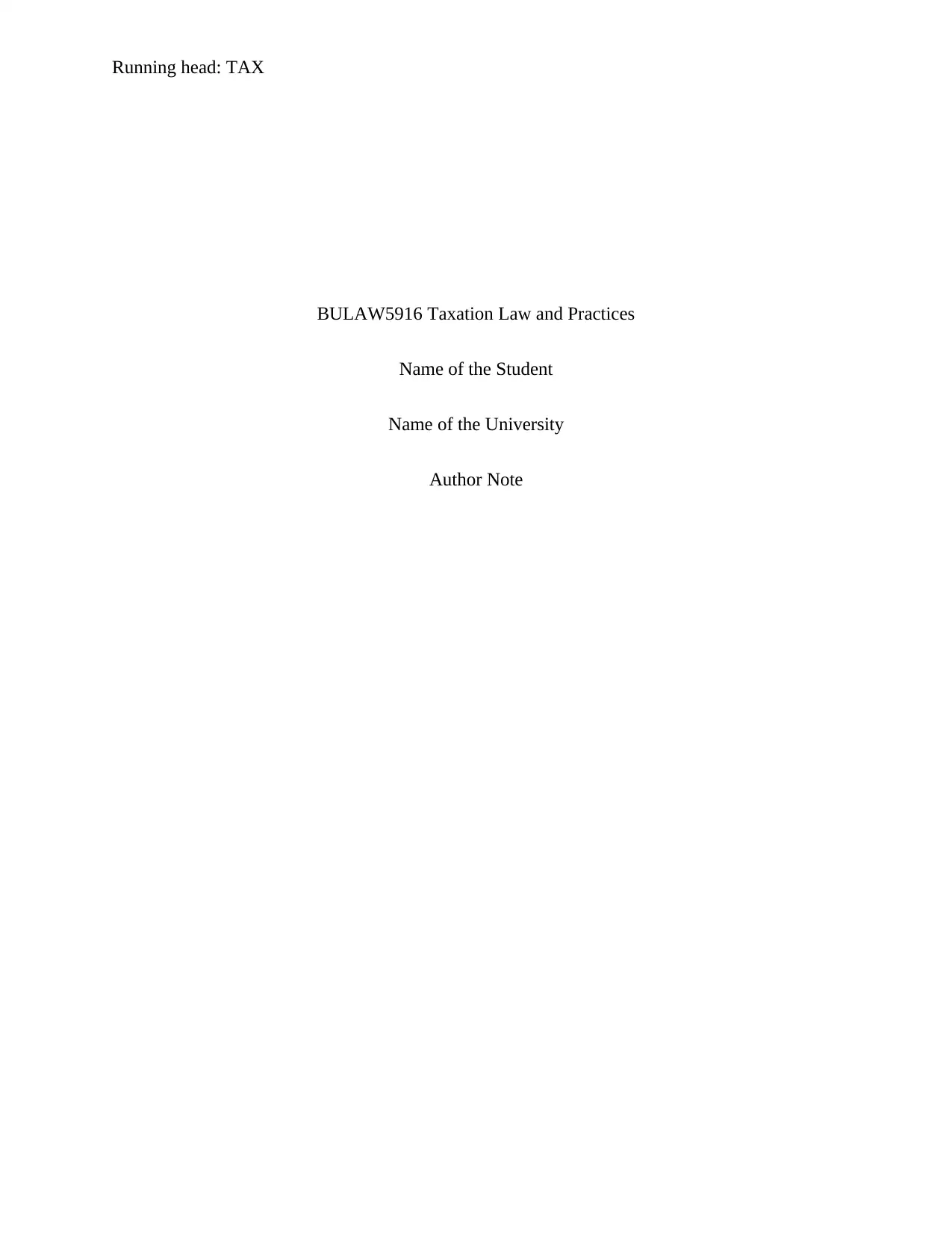
Running head: TAX
BULAW5916 Taxation Law and Practices
Name of the Student
Name of the University
Author Note
BULAW5916 Taxation Law and Practices
Name of the Student
Name of the University
Author Note
Paraphrase This Document
Need a fresh take? Get an instant paraphrase of this document with our AI Paraphraser
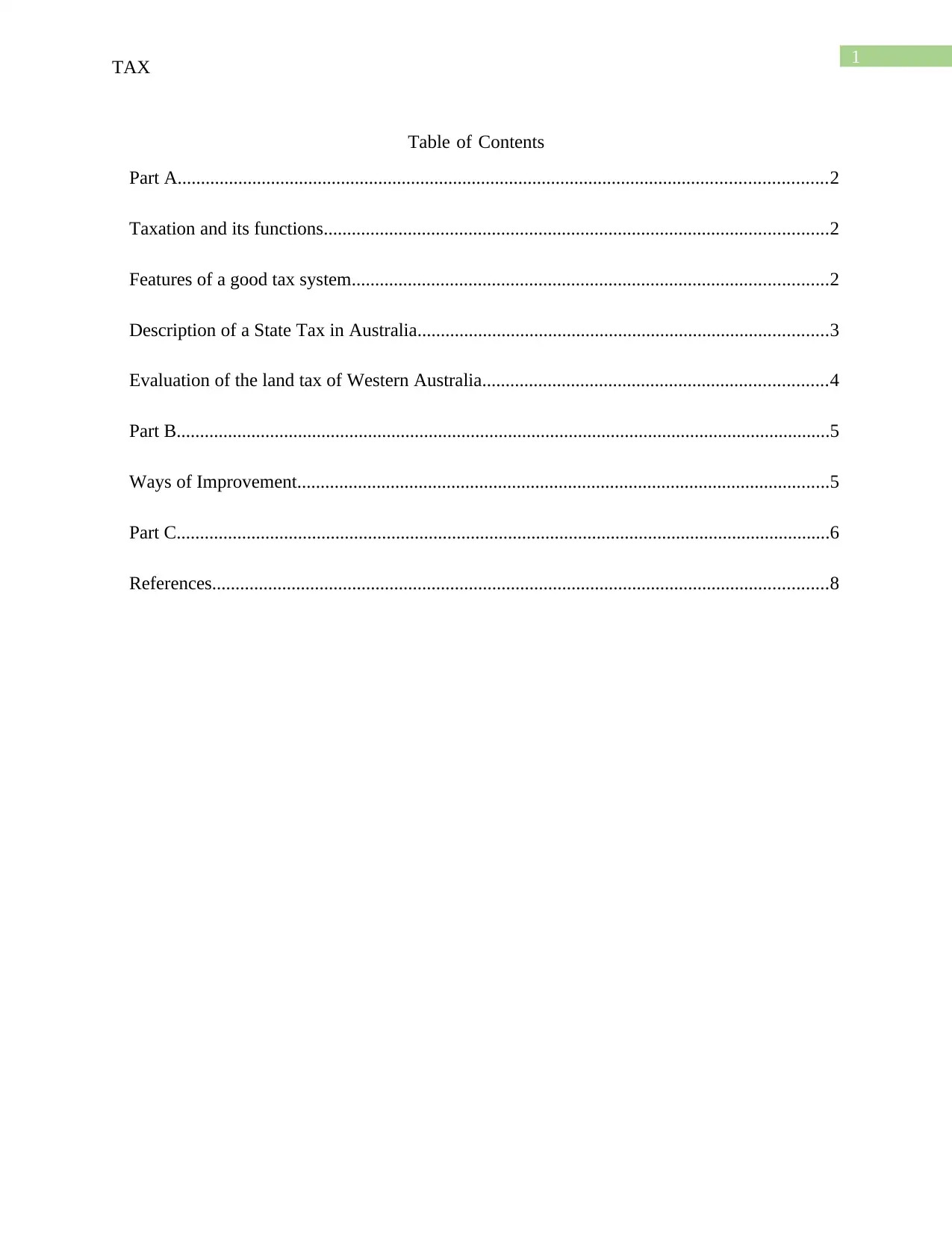
1
TAX
Table of Contents
Part A...........................................................................................................................................2
Taxation and its functions............................................................................................................2
Features of a good tax system......................................................................................................2
Description of a State Tax in Australia........................................................................................3
Evaluation of the land tax of Western Australia..........................................................................4
Part B............................................................................................................................................5
Ways of Improvement..................................................................................................................5
Part C............................................................................................................................................6
References....................................................................................................................................8
TAX
Table of Contents
Part A...........................................................................................................................................2
Taxation and its functions............................................................................................................2
Features of a good tax system......................................................................................................2
Description of a State Tax in Australia........................................................................................3
Evaluation of the land tax of Western Australia..........................................................................4
Part B............................................................................................................................................5
Ways of Improvement..................................................................................................................5
Part C............................................................................................................................................6
References....................................................................................................................................8
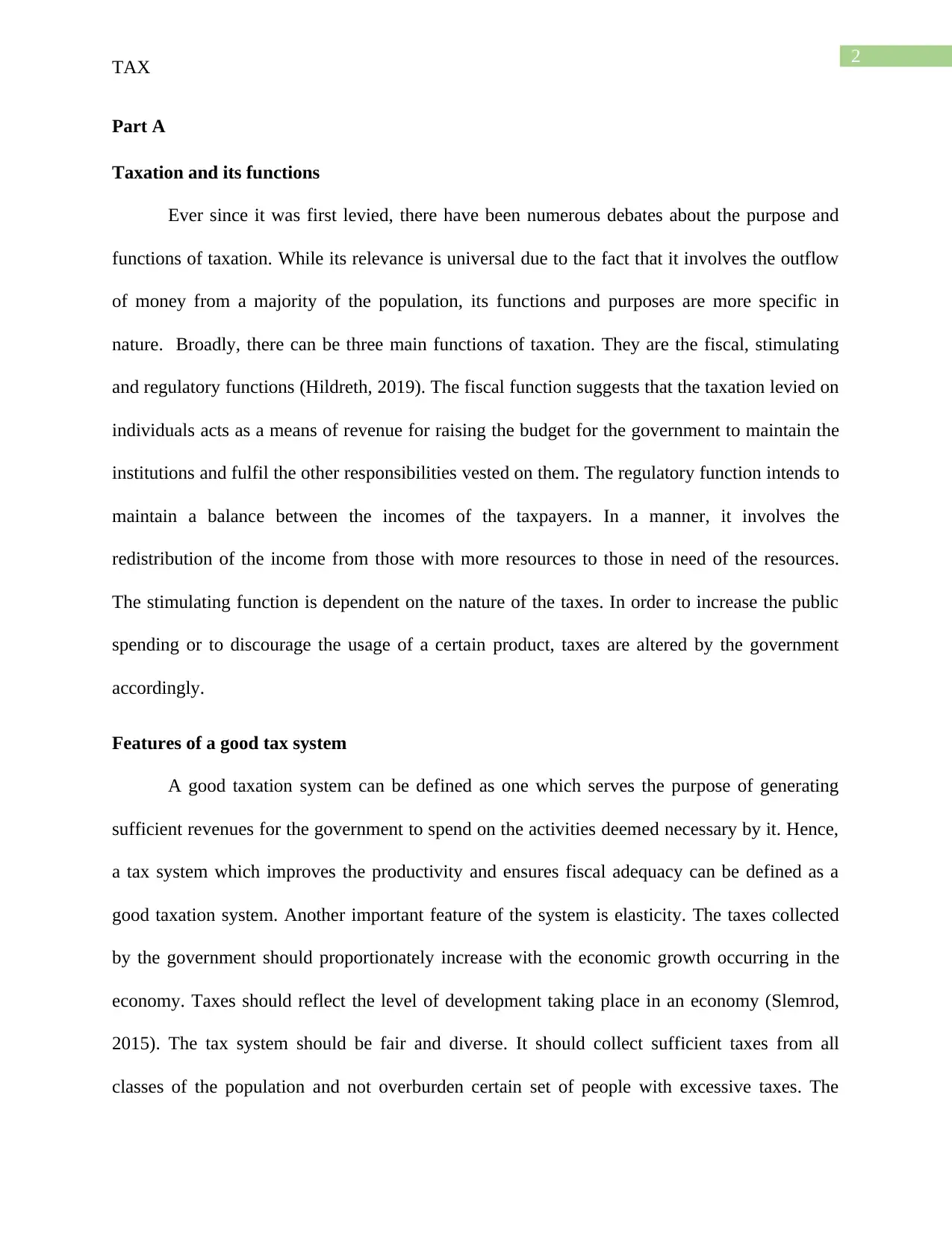
2
TAX
Part A
Taxation and its functions
Ever since it was first levied, there have been numerous debates about the purpose and
functions of taxation. While its relevance is universal due to the fact that it involves the outflow
of money from a majority of the population, its functions and purposes are more specific in
nature. Broadly, there can be three main functions of taxation. They are the fiscal, stimulating
and regulatory functions (Hildreth, 2019). The fiscal function suggests that the taxation levied on
individuals acts as a means of revenue for raising the budget for the government to maintain the
institutions and fulfil the other responsibilities vested on them. The regulatory function intends to
maintain a balance between the incomes of the taxpayers. In a manner, it involves the
redistribution of the income from those with more resources to those in need of the resources.
The stimulating function is dependent on the nature of the taxes. In order to increase the public
spending or to discourage the usage of a certain product, taxes are altered by the government
accordingly.
Features of a good tax system
A good taxation system can be defined as one which serves the purpose of generating
sufficient revenues for the government to spend on the activities deemed necessary by it. Hence,
a tax system which improves the productivity and ensures fiscal adequacy can be defined as a
good taxation system. Another important feature of the system is elasticity. The taxes collected
by the government should proportionately increase with the economic growth occurring in the
economy. Taxes should reflect the level of development taking place in an economy (Slemrod,
2015). The tax system should be fair and diverse. It should collect sufficient taxes from all
classes of the population and not overburden certain set of people with excessive taxes. The
TAX
Part A
Taxation and its functions
Ever since it was first levied, there have been numerous debates about the purpose and
functions of taxation. While its relevance is universal due to the fact that it involves the outflow
of money from a majority of the population, its functions and purposes are more specific in
nature. Broadly, there can be three main functions of taxation. They are the fiscal, stimulating
and regulatory functions (Hildreth, 2019). The fiscal function suggests that the taxation levied on
individuals acts as a means of revenue for raising the budget for the government to maintain the
institutions and fulfil the other responsibilities vested on them. The regulatory function intends to
maintain a balance between the incomes of the taxpayers. In a manner, it involves the
redistribution of the income from those with more resources to those in need of the resources.
The stimulating function is dependent on the nature of the taxes. In order to increase the public
spending or to discourage the usage of a certain product, taxes are altered by the government
accordingly.
Features of a good tax system
A good taxation system can be defined as one which serves the purpose of generating
sufficient revenues for the government to spend on the activities deemed necessary by it. Hence,
a tax system which improves the productivity and ensures fiscal adequacy can be defined as a
good taxation system. Another important feature of the system is elasticity. The taxes collected
by the government should proportionately increase with the economic growth occurring in the
economy. Taxes should reflect the level of development taking place in an economy (Slemrod,
2015). The tax system should be fair and diverse. It should collect sufficient taxes from all
classes of the population and not overburden certain set of people with excessive taxes. The
⊘ This is a preview!⊘
Do you want full access?
Subscribe today to unlock all pages.

Trusted by 1+ million students worldwide
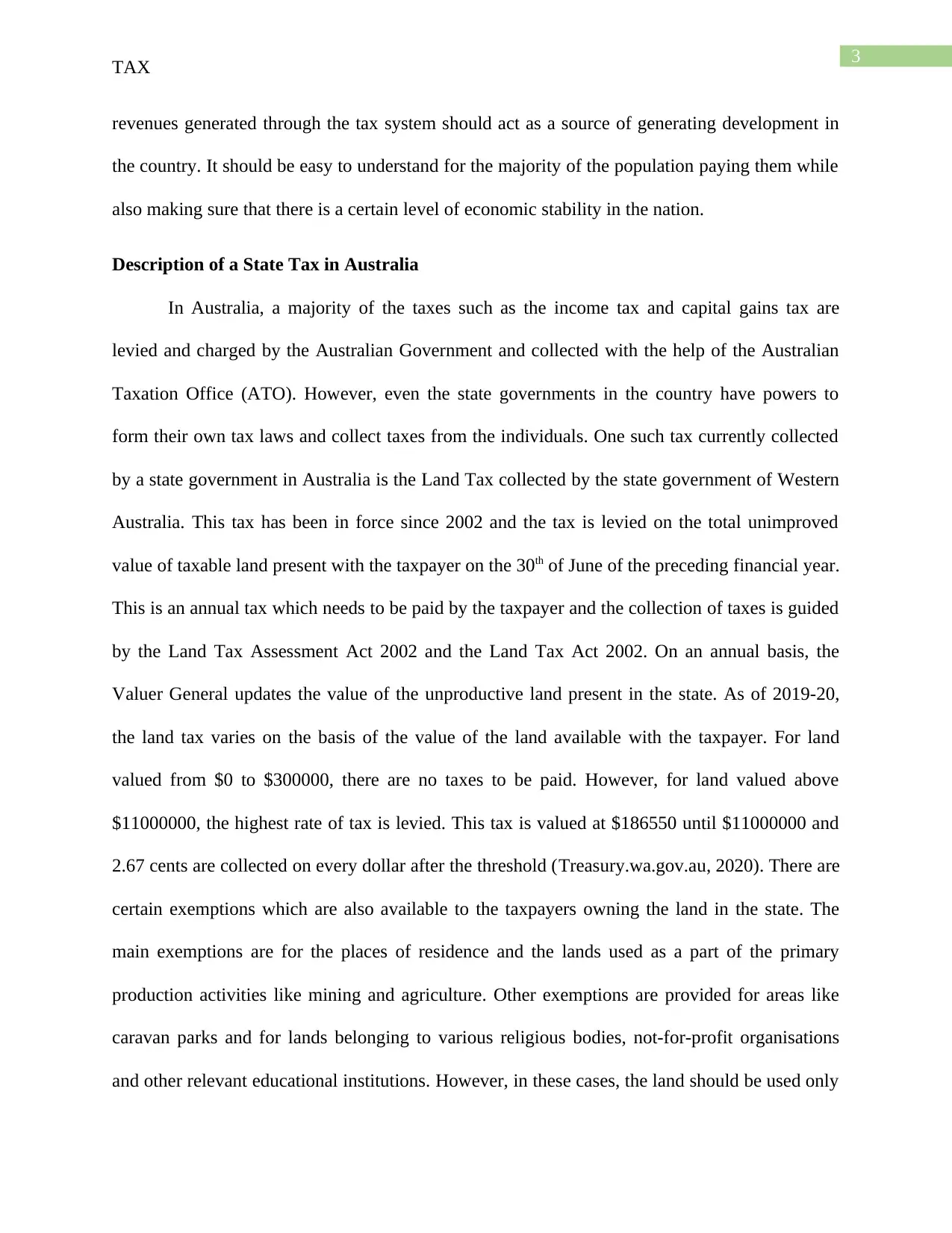
3
TAX
revenues generated through the tax system should act as a source of generating development in
the country. It should be easy to understand for the majority of the population paying them while
also making sure that there is a certain level of economic stability in the nation.
Description of a State Tax in Australia
In Australia, a majority of the taxes such as the income tax and capital gains tax are
levied and charged by the Australian Government and collected with the help of the Australian
Taxation Office (ATO). However, even the state governments in the country have powers to
form their own tax laws and collect taxes from the individuals. One such tax currently collected
by a state government in Australia is the Land Tax collected by the state government of Western
Australia. This tax has been in force since 2002 and the tax is levied on the total unimproved
value of taxable land present with the taxpayer on the 30th of June of the preceding financial year.
This is an annual tax which needs to be paid by the taxpayer and the collection of taxes is guided
by the Land Tax Assessment Act 2002 and the Land Tax Act 2002. On an annual basis, the
Valuer General updates the value of the unproductive land present in the state. As of 2019-20,
the land tax varies on the basis of the value of the land available with the taxpayer. For land
valued from $0 to $300000, there are no taxes to be paid. However, for land valued above
$11000000, the highest rate of tax is levied. This tax is valued at $186550 until $11000000 and
2.67 cents are collected on every dollar after the threshold (Treasury.wa.gov.au, 2020). There are
certain exemptions which are also available to the taxpayers owning the land in the state. The
main exemptions are for the places of residence and the lands used as a part of the primary
production activities like mining and agriculture. Other exemptions are provided for areas like
caravan parks and for lands belonging to various religious bodies, not-for-profit organisations
and other relevant educational institutions. However, in these cases, the land should be used only
TAX
revenues generated through the tax system should act as a source of generating development in
the country. It should be easy to understand for the majority of the population paying them while
also making sure that there is a certain level of economic stability in the nation.
Description of a State Tax in Australia
In Australia, a majority of the taxes such as the income tax and capital gains tax are
levied and charged by the Australian Government and collected with the help of the Australian
Taxation Office (ATO). However, even the state governments in the country have powers to
form their own tax laws and collect taxes from the individuals. One such tax currently collected
by a state government in Australia is the Land Tax collected by the state government of Western
Australia. This tax has been in force since 2002 and the tax is levied on the total unimproved
value of taxable land present with the taxpayer on the 30th of June of the preceding financial year.
This is an annual tax which needs to be paid by the taxpayer and the collection of taxes is guided
by the Land Tax Assessment Act 2002 and the Land Tax Act 2002. On an annual basis, the
Valuer General updates the value of the unproductive land present in the state. As of 2019-20,
the land tax varies on the basis of the value of the land available with the taxpayer. For land
valued from $0 to $300000, there are no taxes to be paid. However, for land valued above
$11000000, the highest rate of tax is levied. This tax is valued at $186550 until $11000000 and
2.67 cents are collected on every dollar after the threshold (Treasury.wa.gov.au, 2020). There are
certain exemptions which are also available to the taxpayers owning the land in the state. The
main exemptions are for the places of residence and the lands used as a part of the primary
production activities like mining and agriculture. Other exemptions are provided for areas like
caravan parks and for lands belonging to various religious bodies, not-for-profit organisations
and other relevant educational institutions. However, in these cases, the land should be used only
Paraphrase This Document
Need a fresh take? Get an instant paraphrase of this document with our AI Paraphraser
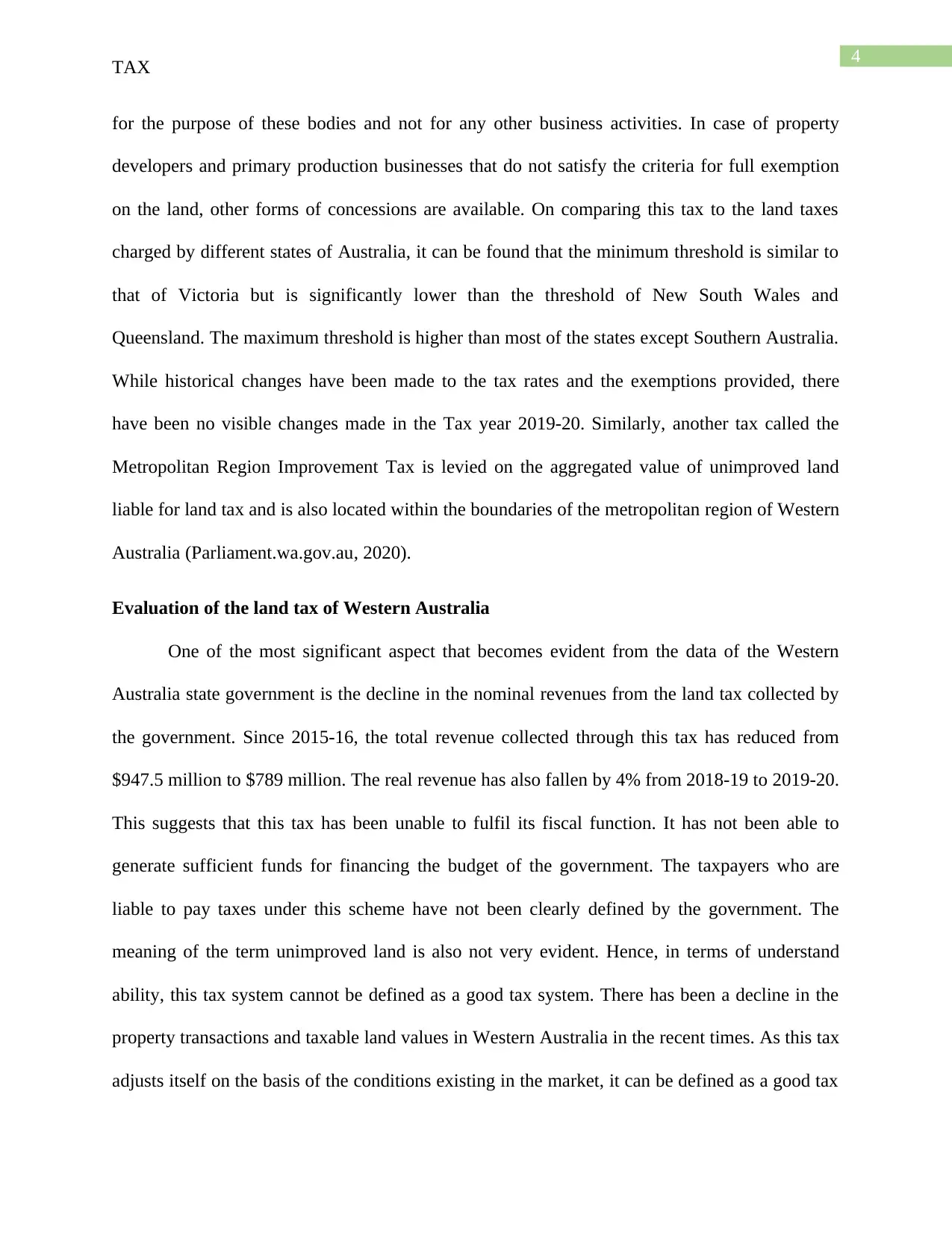
4
TAX
for the purpose of these bodies and not for any other business activities. In case of property
developers and primary production businesses that do not satisfy the criteria for full exemption
on the land, other forms of concessions are available. On comparing this tax to the land taxes
charged by different states of Australia, it can be found that the minimum threshold is similar to
that of Victoria but is significantly lower than the threshold of New South Wales and
Queensland. The maximum threshold is higher than most of the states except Southern Australia.
While historical changes have been made to the tax rates and the exemptions provided, there
have been no visible changes made in the Tax year 2019-20. Similarly, another tax called the
Metropolitan Region Improvement Tax is levied on the aggregated value of unimproved land
liable for land tax and is also located within the boundaries of the metropolitan region of Western
Australia (Parliament.wa.gov.au, 2020).
Evaluation of the land tax of Western Australia
One of the most significant aspect that becomes evident from the data of the Western
Australia state government is the decline in the nominal revenues from the land tax collected by
the government. Since 2015-16, the total revenue collected through this tax has reduced from
$947.5 million to $789 million. The real revenue has also fallen by 4% from 2018-19 to 2019-20.
This suggests that this tax has been unable to fulfil its fiscal function. It has not been able to
generate sufficient funds for financing the budget of the government. The taxpayers who are
liable to pay taxes under this scheme have not been clearly defined by the government. The
meaning of the term unimproved land is also not very evident. Hence, in terms of understand
ability, this tax system cannot be defined as a good tax system. There has been a decline in the
property transactions and taxable land values in Western Australia in the recent times. As this tax
adjusts itself on the basis of the conditions existing in the market, it can be defined as a good tax
TAX
for the purpose of these bodies and not for any other business activities. In case of property
developers and primary production businesses that do not satisfy the criteria for full exemption
on the land, other forms of concessions are available. On comparing this tax to the land taxes
charged by different states of Australia, it can be found that the minimum threshold is similar to
that of Victoria but is significantly lower than the threshold of New South Wales and
Queensland. The maximum threshold is higher than most of the states except Southern Australia.
While historical changes have been made to the tax rates and the exemptions provided, there
have been no visible changes made in the Tax year 2019-20. Similarly, another tax called the
Metropolitan Region Improvement Tax is levied on the aggregated value of unimproved land
liable for land tax and is also located within the boundaries of the metropolitan region of Western
Australia (Parliament.wa.gov.au, 2020).
Evaluation of the land tax of Western Australia
One of the most significant aspect that becomes evident from the data of the Western
Australia state government is the decline in the nominal revenues from the land tax collected by
the government. Since 2015-16, the total revenue collected through this tax has reduced from
$947.5 million to $789 million. The real revenue has also fallen by 4% from 2018-19 to 2019-20.
This suggests that this tax has been unable to fulfil its fiscal function. It has not been able to
generate sufficient funds for financing the budget of the government. The taxpayers who are
liable to pay taxes under this scheme have not been clearly defined by the government. The
meaning of the term unimproved land is also not very evident. Hence, in terms of understand
ability, this tax system cannot be defined as a good tax system. There has been a decline in the
property transactions and taxable land values in Western Australia in the recent times. As this tax
adjusts itself on the basis of the conditions existing in the market, it can be defined as a good tax
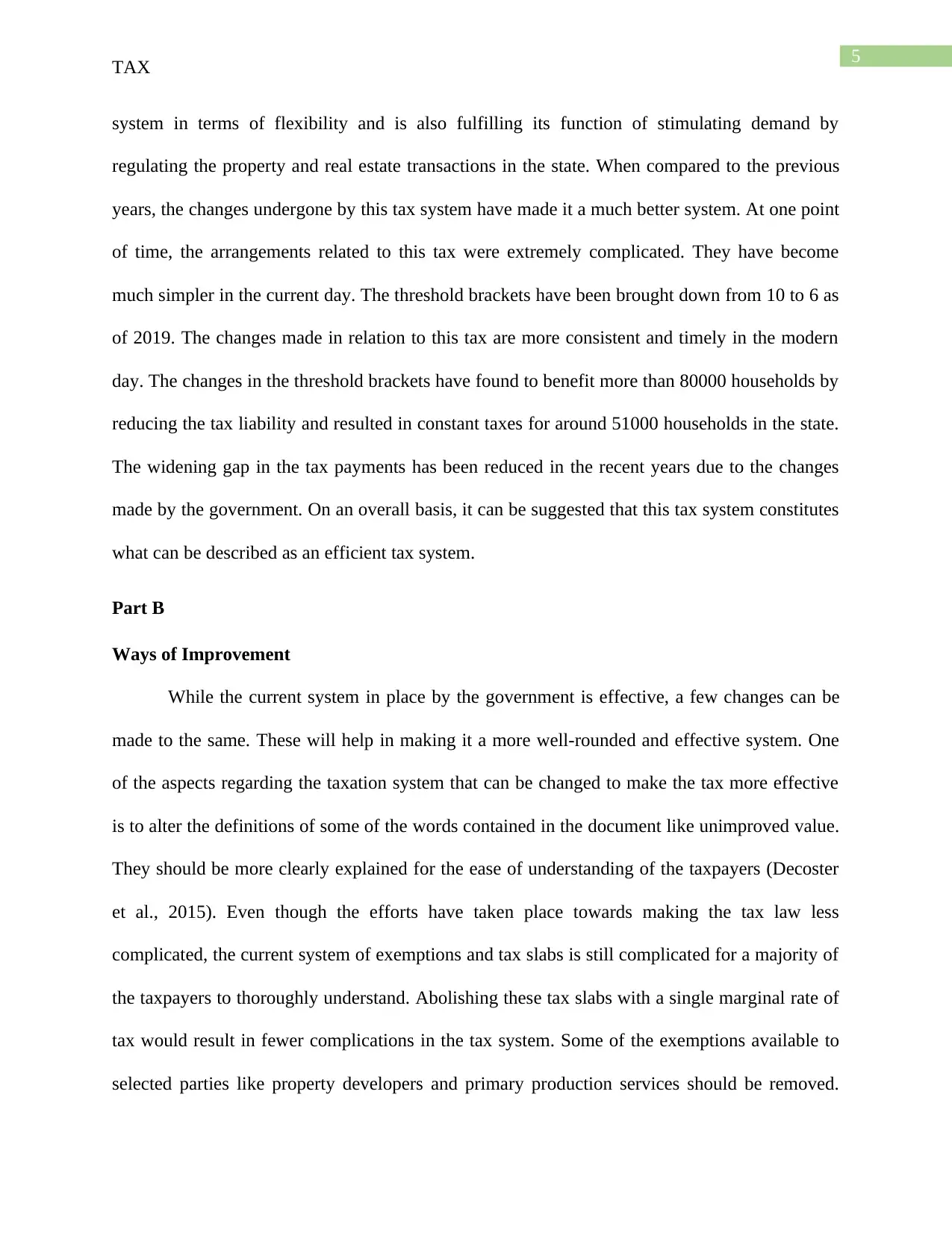
5
TAX
system in terms of flexibility and is also fulfilling its function of stimulating demand by
regulating the property and real estate transactions in the state. When compared to the previous
years, the changes undergone by this tax system have made it a much better system. At one point
of time, the arrangements related to this tax were extremely complicated. They have become
much simpler in the current day. The threshold brackets have been brought down from 10 to 6 as
of 2019. The changes made in relation to this tax are more consistent and timely in the modern
day. The changes in the threshold brackets have found to benefit more than 80000 households by
reducing the tax liability and resulted in constant taxes for around 51000 households in the state.
The widening gap in the tax payments has been reduced in the recent years due to the changes
made by the government. On an overall basis, it can be suggested that this tax system constitutes
what can be described as an efficient tax system.
Part B
Ways of Improvement
While the current system in place by the government is effective, a few changes can be
made to the same. These will help in making it a more well-rounded and effective system. One
of the aspects regarding the taxation system that can be changed to make the tax more effective
is to alter the definitions of some of the words contained in the document like unimproved value.
They should be more clearly explained for the ease of understanding of the taxpayers (Decoster
et al., 2015). Even though the efforts have taken place towards making the tax law less
complicated, the current system of exemptions and tax slabs is still complicated for a majority of
the taxpayers to thoroughly understand. Abolishing these tax slabs with a single marginal rate of
tax would result in fewer complications in the tax system. Some of the exemptions available to
selected parties like property developers and primary production services should be removed.
TAX
system in terms of flexibility and is also fulfilling its function of stimulating demand by
regulating the property and real estate transactions in the state. When compared to the previous
years, the changes undergone by this tax system have made it a much better system. At one point
of time, the arrangements related to this tax were extremely complicated. They have become
much simpler in the current day. The threshold brackets have been brought down from 10 to 6 as
of 2019. The changes made in relation to this tax are more consistent and timely in the modern
day. The changes in the threshold brackets have found to benefit more than 80000 households by
reducing the tax liability and resulted in constant taxes for around 51000 households in the state.
The widening gap in the tax payments has been reduced in the recent years due to the changes
made by the government. On an overall basis, it can be suggested that this tax system constitutes
what can be described as an efficient tax system.
Part B
Ways of Improvement
While the current system in place by the government is effective, a few changes can be
made to the same. These will help in making it a more well-rounded and effective system. One
of the aspects regarding the taxation system that can be changed to make the tax more effective
is to alter the definitions of some of the words contained in the document like unimproved value.
They should be more clearly explained for the ease of understanding of the taxpayers (Decoster
et al., 2015). Even though the efforts have taken place towards making the tax law less
complicated, the current system of exemptions and tax slabs is still complicated for a majority of
the taxpayers to thoroughly understand. Abolishing these tax slabs with a single marginal rate of
tax would result in fewer complications in the tax system. Some of the exemptions available to
selected parties like property developers and primary production services should be removed.
⊘ This is a preview!⊘
Do you want full access?
Subscribe today to unlock all pages.

Trusted by 1+ million students worldwide
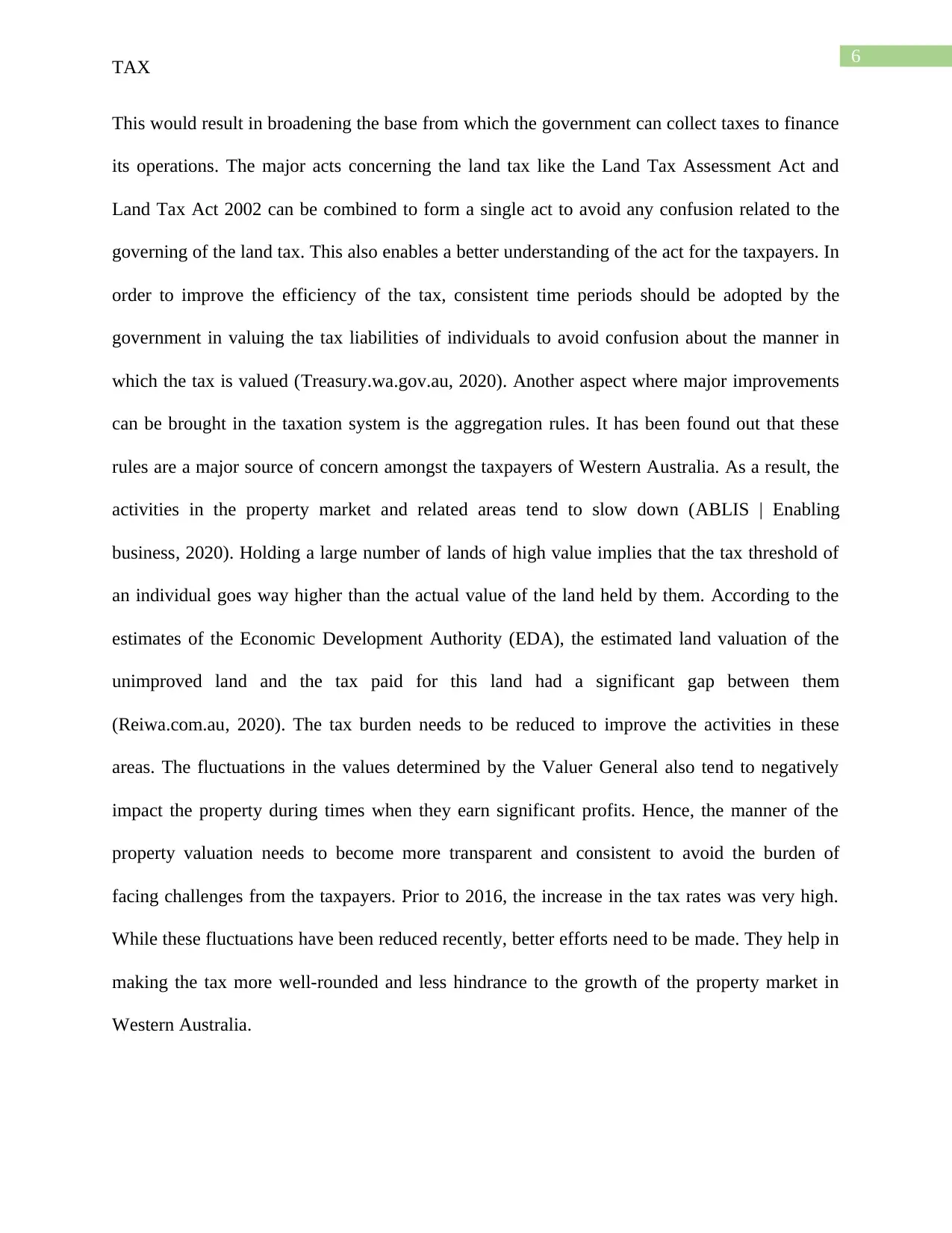
6
TAX
This would result in broadening the base from which the government can collect taxes to finance
its operations. The major acts concerning the land tax like the Land Tax Assessment Act and
Land Tax Act 2002 can be combined to form a single act to avoid any confusion related to the
governing of the land tax. This also enables a better understanding of the act for the taxpayers. In
order to improve the efficiency of the tax, consistent time periods should be adopted by the
government in valuing the tax liabilities of individuals to avoid confusion about the manner in
which the tax is valued (Treasury.wa.gov.au, 2020). Another aspect where major improvements
can be brought in the taxation system is the aggregation rules. It has been found out that these
rules are a major source of concern amongst the taxpayers of Western Australia. As a result, the
activities in the property market and related areas tend to slow down (ABLIS | Enabling
business, 2020). Holding a large number of lands of high value implies that the tax threshold of
an individual goes way higher than the actual value of the land held by them. According to the
estimates of the Economic Development Authority (EDA), the estimated land valuation of the
unimproved land and the tax paid for this land had a significant gap between them
(Reiwa.com.au, 2020). The tax burden needs to be reduced to improve the activities in these
areas. The fluctuations in the values determined by the Valuer General also tend to negatively
impact the property during times when they earn significant profits. Hence, the manner of the
property valuation needs to become more transparent and consistent to avoid the burden of
facing challenges from the taxpayers. Prior to 2016, the increase in the tax rates was very high.
While these fluctuations have been reduced recently, better efforts need to be made. They help in
making the tax more well-rounded and less hindrance to the growth of the property market in
Western Australia.
TAX
This would result in broadening the base from which the government can collect taxes to finance
its operations. The major acts concerning the land tax like the Land Tax Assessment Act and
Land Tax Act 2002 can be combined to form a single act to avoid any confusion related to the
governing of the land tax. This also enables a better understanding of the act for the taxpayers. In
order to improve the efficiency of the tax, consistent time periods should be adopted by the
government in valuing the tax liabilities of individuals to avoid confusion about the manner in
which the tax is valued (Treasury.wa.gov.au, 2020). Another aspect where major improvements
can be brought in the taxation system is the aggregation rules. It has been found out that these
rules are a major source of concern amongst the taxpayers of Western Australia. As a result, the
activities in the property market and related areas tend to slow down (ABLIS | Enabling
business, 2020). Holding a large number of lands of high value implies that the tax threshold of
an individual goes way higher than the actual value of the land held by them. According to the
estimates of the Economic Development Authority (EDA), the estimated land valuation of the
unimproved land and the tax paid for this land had a significant gap between them
(Reiwa.com.au, 2020). The tax burden needs to be reduced to improve the activities in these
areas. The fluctuations in the values determined by the Valuer General also tend to negatively
impact the property during times when they earn significant profits. Hence, the manner of the
property valuation needs to become more transparent and consistent to avoid the burden of
facing challenges from the taxpayers. Prior to 2016, the increase in the tax rates was very high.
While these fluctuations have been reduced recently, better efforts need to be made. They help in
making the tax more well-rounded and less hindrance to the growth of the property market in
Western Australia.
Paraphrase This Document
Need a fresh take? Get an instant paraphrase of this document with our AI Paraphraser
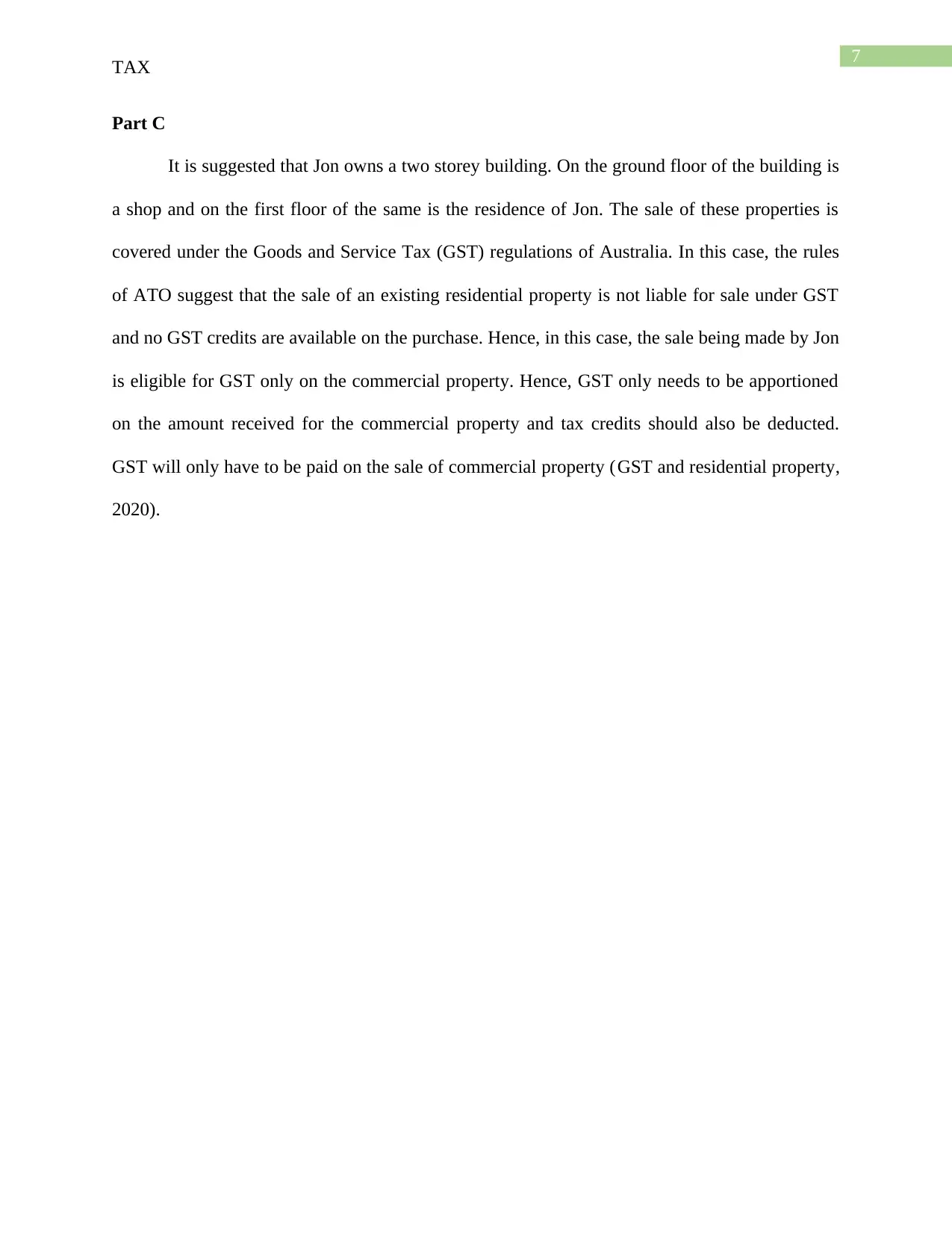
7
TAX
Part C
It is suggested that Jon owns a two storey building. On the ground floor of the building is
a shop and on the first floor of the same is the residence of Jon. The sale of these properties is
covered under the Goods and Service Tax (GST) regulations of Australia. In this case, the rules
of ATO suggest that the sale of an existing residential property is not liable for sale under GST
and no GST credits are available on the purchase. Hence, in this case, the sale being made by Jon
is eligible for GST only on the commercial property. Hence, GST only needs to be apportioned
on the amount received for the commercial property and tax credits should also be deducted.
GST will only have to be paid on the sale of commercial property (GST and residential property,
2020).
TAX
Part C
It is suggested that Jon owns a two storey building. On the ground floor of the building is
a shop and on the first floor of the same is the residence of Jon. The sale of these properties is
covered under the Goods and Service Tax (GST) regulations of Australia. In this case, the rules
of ATO suggest that the sale of an existing residential property is not liable for sale under GST
and no GST credits are available on the purchase. Hence, in this case, the sale being made by Jon
is eligible for GST only on the commercial property. Hence, GST only needs to be apportioned
on the amount received for the commercial property and tax credits should also be deducted.
GST will only have to be paid on the sale of commercial property (GST and residential property,
2020).
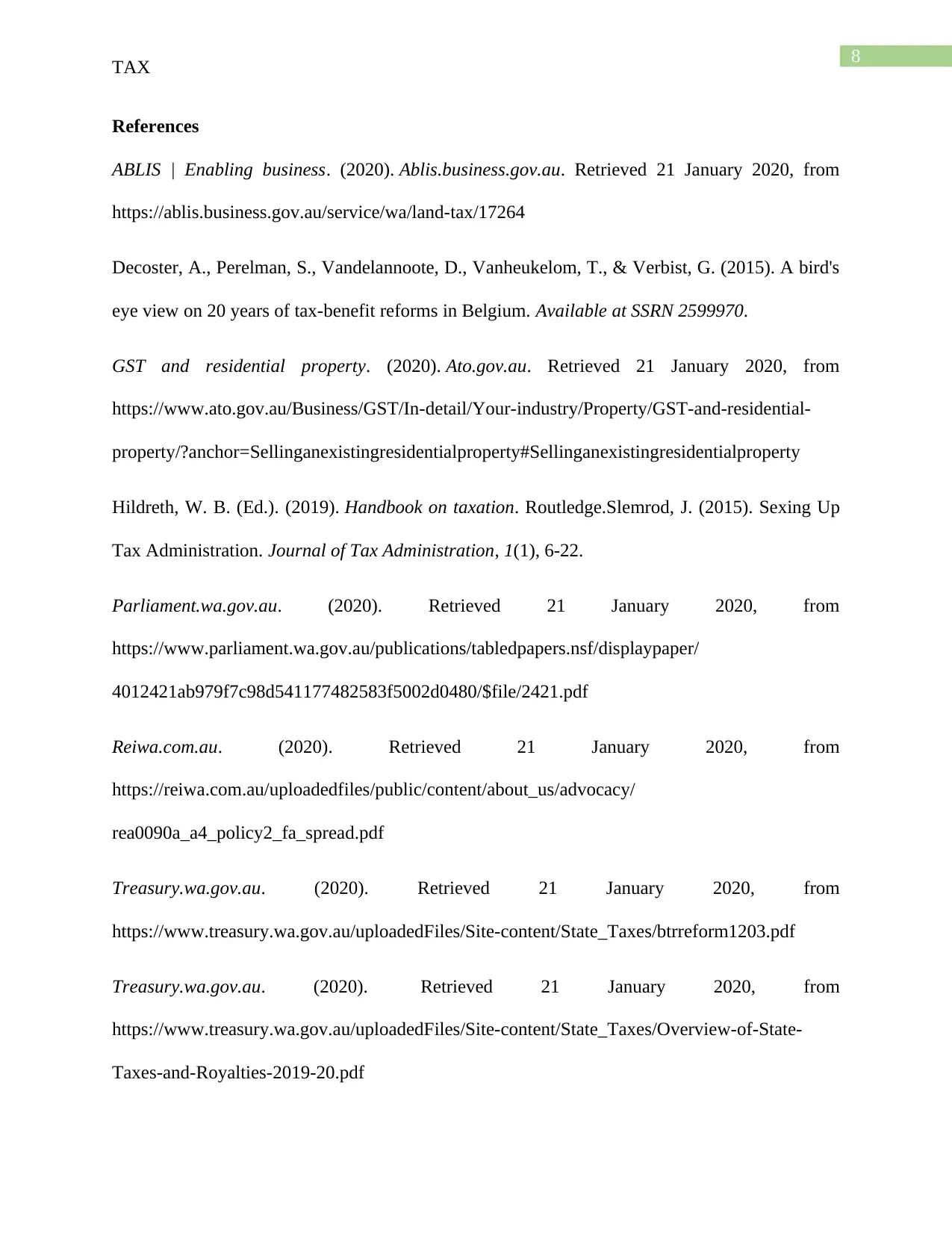
8
TAX
References
ABLIS | Enabling business. (2020). Ablis.business.gov.au. Retrieved 21 January 2020, from
https://ablis.business.gov.au/service/wa/land-tax/17264
Decoster, A., Perelman, S., Vandelannoote, D., Vanheukelom, T., & Verbist, G. (2015). A bird's
eye view on 20 years of tax-benefit reforms in Belgium. Available at SSRN 2599970.
GST and residential property. (2020). Ato.gov.au. Retrieved 21 January 2020, from
https://www.ato.gov.au/Business/GST/In-detail/Your-industry/Property/GST-and-residential-
property/?anchor=Sellinganexistingresidentialproperty#Sellinganexistingresidentialproperty
Hildreth, W. B. (Ed.). (2019). Handbook on taxation. Routledge.Slemrod, J. (2015). Sexing Up
Tax Administration. Journal of Tax Administration, 1(1), 6-22.
Parliament.wa.gov.au. (2020). Retrieved 21 January 2020, from
https://www.parliament.wa.gov.au/publications/tabledpapers.nsf/displaypaper/
4012421ab979f7c98d541177482583f5002d0480/$file/2421.pdf
Reiwa.com.au. (2020). Retrieved 21 January 2020, from
https://reiwa.com.au/uploadedfiles/public/content/about_us/advocacy/
rea0090a_a4_policy2_fa_spread.pdf
Treasury.wa.gov.au. (2020). Retrieved 21 January 2020, from
https://www.treasury.wa.gov.au/uploadedFiles/Site-content/State_Taxes/btrreform1203.pdf
Treasury.wa.gov.au. (2020). Retrieved 21 January 2020, from
https://www.treasury.wa.gov.au/uploadedFiles/Site-content/State_Taxes/Overview-of-State-
Taxes-and-Royalties-2019-20.pdf
TAX
References
ABLIS | Enabling business. (2020). Ablis.business.gov.au. Retrieved 21 January 2020, from
https://ablis.business.gov.au/service/wa/land-tax/17264
Decoster, A., Perelman, S., Vandelannoote, D., Vanheukelom, T., & Verbist, G. (2015). A bird's
eye view on 20 years of tax-benefit reforms in Belgium. Available at SSRN 2599970.
GST and residential property. (2020). Ato.gov.au. Retrieved 21 January 2020, from
https://www.ato.gov.au/Business/GST/In-detail/Your-industry/Property/GST-and-residential-
property/?anchor=Sellinganexistingresidentialproperty#Sellinganexistingresidentialproperty
Hildreth, W. B. (Ed.). (2019). Handbook on taxation. Routledge.Slemrod, J. (2015). Sexing Up
Tax Administration. Journal of Tax Administration, 1(1), 6-22.
Parliament.wa.gov.au. (2020). Retrieved 21 January 2020, from
https://www.parliament.wa.gov.au/publications/tabledpapers.nsf/displaypaper/
4012421ab979f7c98d541177482583f5002d0480/$file/2421.pdf
Reiwa.com.au. (2020). Retrieved 21 January 2020, from
https://reiwa.com.au/uploadedfiles/public/content/about_us/advocacy/
rea0090a_a4_policy2_fa_spread.pdf
Treasury.wa.gov.au. (2020). Retrieved 21 January 2020, from
https://www.treasury.wa.gov.au/uploadedFiles/Site-content/State_Taxes/btrreform1203.pdf
Treasury.wa.gov.au. (2020). Retrieved 21 January 2020, from
https://www.treasury.wa.gov.au/uploadedFiles/Site-content/State_Taxes/Overview-of-State-
Taxes-and-Royalties-2019-20.pdf
⊘ This is a preview!⊘
Do you want full access?
Subscribe today to unlock all pages.

Trusted by 1+ million students worldwide
1 out of 9
Related Documents
Your All-in-One AI-Powered Toolkit for Academic Success.
+13062052269
info@desklib.com
Available 24*7 on WhatsApp / Email
![[object Object]](/_next/static/media/star-bottom.7253800d.svg)
Unlock your academic potential
Copyright © 2020–2025 A2Z Services. All Rights Reserved. Developed and managed by ZUCOL.





